Physical Address
304 North Cardinal St.
Dorchester Center, MA 02124
Vascular problems involving the shoulder are relatively uncommon, but they can result in pain, a profound deleterious effect on an athlete's performance, and, in rare cases, a potentially limb-threatening situation. Acute sports-related vascular injuries are most common in contact sports and can occur as a result of blunt or penetrating trauma. The possibility of penetration of a bone fragment in fractures underscores the need for the rapid assessment of vascular status with a physical examination, plain radiography, and arteriography if necessary. Delayed presentation of vascular injuries can be the result of compression or abnormality within the thoracic outlet. The thoracic outlet, which involves the area of the shoulder girdle in which the subclavian artery and vein exit the chest cavity along with the brachial plexus, is vulnerable to injury because of its crowded confines in combination with the high mobility of the glenohumeral and scapulothoracic articulations.
Thoracic outlet syndrome (TOS) generally defines any compression of brachial plexus elements and/or subclavian vessels as they pass from the intrathoracic area through the ribs into the axilla and proximal arm. However, it is important to identify the particular neurovascular structures involved in attempting to diagnose and treat TOS. Variability in the presenting symptoms of TOS poses a challenge for the clinician and highlights the importance of obtaining a careful history and performing a thorough physical examination. The various names referred to as TOS attest to its confusing nature ( Box 55.1 ).
Shoulder-hand syndrome
Paget-Schroetter syndrome
Cervical rib syndrome
First thoracic rib syndrome
Scalenus anterior syndrome
Brachiocephalic syndrome
Scalenus minimus syndrome
Scalenus medius band syndrome
Costoclavicular syndrome
Humeral head syndrome
Hyperabduction syndrome
Nocturnal paresthetic brachialgia
Fractured clavicle syndrome
Pneumatic hammer syndrome
Cervicobrachial neurovascular compression syndrome
Effort vein thrombosis
Rucksack paralysis
Pectoralis minor syndrome
Cervicothoracic outlet syndrome
Subcoracoid syndrome
Syndrome of the scalenus medius band
Naffziger syndrome
Acroparesthesia
Historically, the first description of the cervical rib and associated symptoms was presented by the German anatomist Hunald in 1842. After the advent of radiographs, Thomas and Cushing described a brachial plexopathy called the cervical rib syndrome and a surgical procedure to correct it in 1903. Neurovascular compression in the thoracic outlet area by structures in addition to the cervical rib were first described by Astley Cooper in 1921. In 1927, Adson and Coffey introduced scalenotomy as a treatment option for cervical rib symptoms. In grouping numerous types of neurovascular compression in the thoracic outlet region, Peet et al. first used the term thoracic outlet syndrome in 1956. Surgical management of TOS evolved in 1966, as Roos described the less morbid transaxillary first rib resection. In 1989, Atasoy introduced a combined approach to TOS consisting of transaxillary first rib resection and transcervical anterior and medial scalenectomy. Today various surgical techniques are used to address any soft tissue or bony structures contributing to compression.
The current classification of TOS focuses on the particular structures that are injured as opposed to the controversial anatomic factors responsible for the injury. In 1984, Wilbourn developed a classification for the TOS disorders based on the vascular or neural elements injured. This classification includes true neurogenic, arterial, venous, traumatic neurovascular, and nonspecific TOS. Clinical features are quite variable between the neurogenic and vascular subtypes of TOS. Neurogenic TOS accounts for more than 90% of all TOS cases, whereas vascular TOS constitutes 3% to 4% of all cases. Most TOS cases are seen in adults between the ages of 20 and 50 years. Vascular TOS is seen equally in nonathletic men and women, but neurogenic TOS is three to four times more likely to occur in women than in men. Among competitive athletes, venous TOS cases predominantly occur in men in their mid-20s. Other neurovascular pathology in the athlete's shoulder region can be attributed to quadrilateral space syndrome (QSS), scapulothoracic dissociation, shoulder dislocation, and sternoclavicular dislocation.
Patients with neurogenic TOS commonly report a history of neck trauma, such as a motor vehicle accident, a violent collision in a sporting event, or repetitive heavy lifting. Complaints consist of paresthesias or weakness of the hand and arm, as well as pain involving the head, neck, shoulder, and back. Symptoms may also include loss of dexterity, muscle spasm, and a feeling of heaviness of the upper extremity. These clinical findings almost never solely involve pain or weakness in the dermatomes and myotomes associated with C8 or T1 compression. Patients may also report cold intolerance, Raynaud phenomenon, coldness of the hand, and color changes as a result of sympathetic overactivity as opposed to ischemia. Finally, nonspecific complaints such as headaches, tinnitus, and vertigo may also be present. In general, patients with true neurogenic TOS have objective motor and/or sensory deficits, whereas patients with nonspecific neurogenic TOS typically have subjective weakness and/or numbness in the upper extremity. Otherwise, these two entities share the same clinical presentation but may have vastly different treatment protocols.
Venous TOS, also known as Paget-Schroetter syndrome, has a variety of clinical presentations. This syndrome often occurs in healthy young men who have participated in excessive upper extremity activities; it is caused by a spontaneous thrombosis of the subclavian or axillary vein. Usually no underlying compressive abnormality exists that predisposes the patient to the thrombosis. After the venous occlusion occurs, the limb feels heavy and becomes edematous and possibly even cyanotic. The patient may have neurologic features, such as pain and paresthesias, because of the vascular insult rather than injury to the nerve itself. The three most important factors that lead to venous TOS in athletes are hypertrophy of the pectoral muscle, fibrosis and thickening of the damaged vessel wall from repetitive activity, and damage to the intima of the vein leading to a thrombogenic surface. The term effort thrombosis has been used to describe this clinical entity, and this diagnosis has been reported in participants in sports such as swimming, tennis, and weight lifting.
Arterial TOS is the least common form of TOS but may have the most serious potential consequences to life or limb. Flow in the subclavian or axillary artery is obstructed, most likely from compression between the anterior scalene muscle (ASM), or a bony anomaly such as a cervical rib or deformed first thoracic rib. The downstream effects of this arterial compression include vessel damage, turbulent blood flow, aneurysm formation, and thrombus formation. Later consequences can include embolization and ischemia of the digits. Importantly, aneurysm or thrombosis formation may not always be explained by direct arterial vessel compression via nearby structures. Kee et al. reported on ischemia of the throwing hand in professional baseball pitchers because of an embolic occlusion from an axillary artery branch aneurysm. These investigators did not detect any direct inducible compression of the artery but attributed the lesion to repetitive injuries to the artery during the throwing movement. Rohrer et al. showed that the subclavian or axillary artery can undergo considerable compression in arms that were hyperextended into a throwing position. These investigators reported an increase of at least 20 mm Hg in arterial blood pressure in athletes and nonathletes when the arm was placed in that position. This condition may be underdiagnosed because its symptoms can mimic fatigue and musculoskeletal pathology in overhead-throwing athletes. Rarer still, arterial TOS can present in children, in which case making a correct diagnosis often involves a lengthy workup.
QSS in athletes is most commonly diagnosed in baseball pitchers and volleyball players. The quadrilateral space is defined as the area enclosed by the teres minor superiorly, the humeral shaft laterally, the teres major inferiorly, and the long head of the triceps medially. The axillary nerve and posterior humeral circumflex artery traverse this space and are subjected to an often overlooked and position-dependent compressive entrapment. Hypertrophy of any one of the three muscular borders may reduce the space available for the neurovascular bundle, leading to QSS symptoms. Fibrous bands within this space, most commonly between the teres major and long head of the triceps, may contribute to the decreased cross-sectional area of the quadrilateral space. Additionally, the circumflex course of these structures predisposes them to tethering and stretch injuries when the arm is abducted and rotated. Symptoms can be quite vague and overlap with other causes of posterior shoulder pain, such as posterior labral injury, rotator cuff tendinosis, and suprascapular nerve entrapment. Generally no motor or sensory deficits are noted on physical examination. A lidocaine block has been described and is positive if the patient no longer has tenderness to palpation or pain with activity after the injection. The clinician must have a high index of suspicion and should rule out other sources of shoulder pathology before making this diagnosis.
Vascular injuries in the area of the shoulder can be potentially life- or limb-threatening conditions. A high level of awareness should be maintained for athletes who sustain clavicular fractures, proximal humerus fractures, glenohumeral joint dislocations, and other blunt or penetrating shoulder trauma. Most vascular injuries to the shoulder region occur as a result of penetrating bone fragments or a foreign object. However, Carli et al. reported a case of isolated axillary artery dissection due to blunt trauma in an ice hockey player. Vascular injuries after dislocations are also relatively uncommon, with an incidence of 0.97% after shoulder dislocation. Signs and symptoms of axillary artery injury after shoulder dislocation may be subtle, develop slowly, or be absent altogether. Pulses are absent in 93% of cases, but because of an extensive network of collateral vessels, distal pulses may still be present. Pain, swelling, an axillary mass, and a neurologic deficit are other findings to note on physical examination. The clinician must carefully evaluate the potential for injury to the axillary artery or its branches when managing cases of shoulder trauma in an athlete.
A thorough understanding of the vascular anatomy of the proximal upper extremity is essential in evaluating and treating potential neurovascular injuries in the area of the shoulder ( Fig. 55.1 ). Blood flows from the heart into the subclavian arteries in each upper extremity, with a short traverse through the innominate artery first on the right. The left subclavian artery arises directly from the arch of the aorta. The subclavian artery then enters the thoracic outlet, confined by the upper border of the first rib, the lower border of the clavicle, and the anterior and middle scalene muscles and extends to the lateral border of the first rib. The artery becomes the axillary artery as it exits from the lateral border of the first rib to the inferior border of the latissimus dorsi. The axillary artery is divided into three anatomic sections by the pectoralis minor tendon, with the first section being above the superior border of the pectoralis minor and giving off the superior thoracic artery inferiorly. The second section of the axillary artery lies deep to the pectoralis minor and gives off the lateral thoracic branch and the thoracoacromial artery, which further divides into the clavicular, acromial, deltoid, and pectoral branches. The third and final section of the axillary artery lies distal to the pectoralis minor and contributes the subscapular artery and the anterior and posterior circumflex arteries. The subscapular artery further divides into the scapular circumflex and thoracodorsal arteries. The anterior circumflex artery provides the majority of blood supply to the humeral head near the intertubercular groove through the arcuate artery, which is an anterolateral ascending branch of the anterior circumflex humeral artery.
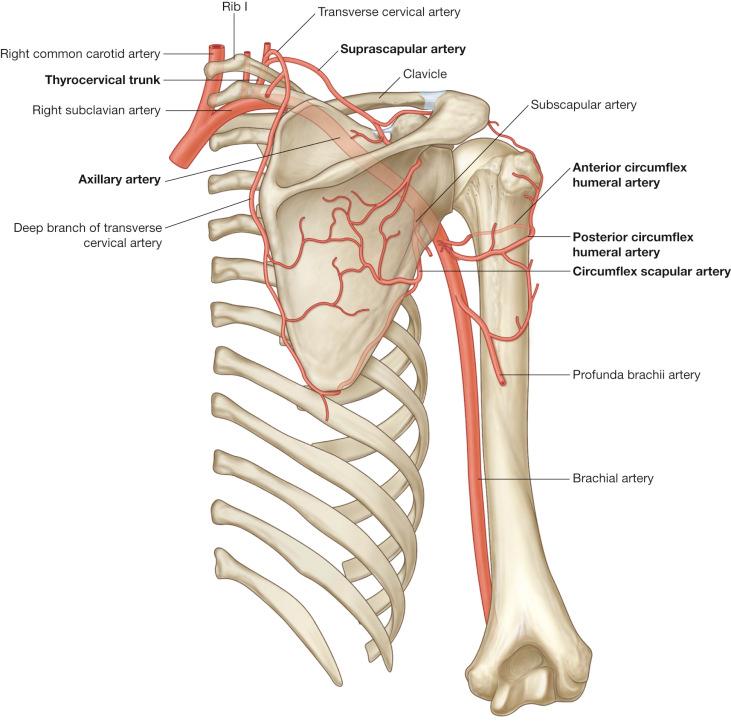
The basilic vein drains the ulnar portion of the hand and forearm and the medial portion of the arm before becoming the axillary vein at the inferior border of the latissimus dorsi. It then becomes the subclavian vein at the lateral border of the first rib before draining into the brachiocephalic vein medially. The cephalic vein is the more lateral superficial vein in the arm and enters the clavipectoral fascia before emptying into the axillary vein. Together, the axillary and cephalic veins account for the majority of the venous drainage in the shoulder. The shoulder lymphatics end in the thoracic and right lymphatic ducts.
Anatomically, the thoracic outlet spans the general area from the supraclavicular fossa to the axilla and includes the area between the clavicle and the first rib. More specifically, the thoracic outlet comprises three confined spaces in which compression can occur ( Fig. 55.2 ). These compartments include the interscalene triangle, the costoclavicular space, and the retropectoralis minor space. The interscalene triangle is bordered anteriorly by the ASM, posteriorly by the middle scalene muscle, and inferiorly by the medial surface of the first rib. The interscalene triangle contains the vast majority of neurovascular compression cases of TOS. The trunks of the brachial plexus and subclavian artery pass through the interscalene triangle, whereas the subclavian vein actually passes anterior to the ASM ( Fig. 55.3 ). The costoclavicular space lies between the clavicle and the first rib posteromedially and the upper border of the scapula posterolaterally. The retropectoralis space lies inferior to the coracoid process beneath the pectoralis minor tendon.
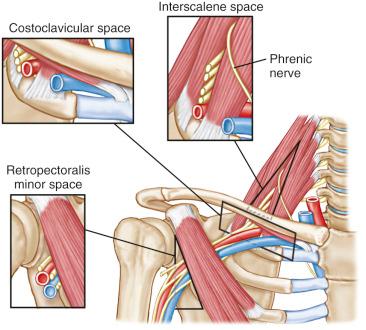
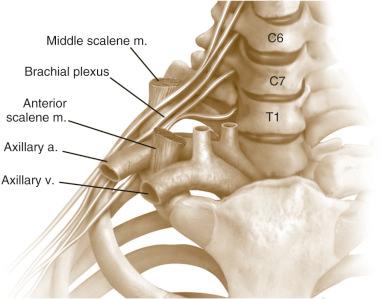
Several bony abnormalities may play a role in compressing structures in the thoracic outlet and causing neurovascular symptoms ( Fig. 55.4 ). Cervical ribs can originate from the seventh cervical vertebra in approximately 1% of the population, with about 10% of those persons having symptoms related to this condition. Various types of cervical ribs can exist, ranging from short bars of bone, incomplete ribs with fibrous bands, and full ribs articulating with the first rib, manubrium, or sternum. In addition, an elongated C7 transverse process can cause compression. Abnormalities such as exostosis, tumor, callus, or fracture of the first rib or clavicle may also be responsible for compressive symptoms. Complications of clavicular fractures such as malunion, fragmentation, and retrosternal dislocation can also increase the risk of developing TOS.
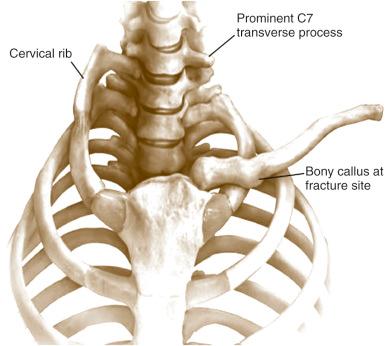
Soft tissue abnormalities such as anomalous fibrous bands and anatomic variations of the scalene muscles can create compression in the thoracic outlet. Roos classified 10 types of fibrous bands in the area of the thoracic outlet that may act to compress its neurovascular structures through direct contact or by compromising the space available within the outlet. Scalene muscle variations that may contribute to TOS include anterior scalene hypertrophy, passage of the brachial plexus through the substance of the ASM, and a broad, anterior insertion of the middle scalene onto the first rib. Potential loading of the neural tissue may also occur if clavicular motion during upper extremity elevation is compromised, particularly with injuries to the acromioclavicular or sternoclavicular joints. Repetitive trauma to the more vulnerable trunk of the lower brachial plexus and C8–T1 spinal nerve roots can play a role in the pathogenesis of TOS.
The patient's history prior to the onset of symptoms is often the most helpful tool in diagnosing TOS. The history may include a neck injury, clavicular fracture, presence of a cervical rib, unusual postural requirements, or strenuous overhead activities. Patients typically report an aching pain radiating from the back of the shoulder region down into the upper extremity. Pain may be accompanied by numbness, tingling, weakness, swelling, coolness, and discoloration. Occasionally pain spreads up the back and into the side of the neck, with an associated ipsilateral hemicranial headache. These symptoms are often exacerbated by arm elevation and by carrying heavy loads. Furthermore, these symptoms progress despite various conservative treatment modalities, such as physical therapy, medications, injections, biofeedback, and psychotherapy.
The differential diagnoses for TOS include any pathology creating pain or weakness in the neck, arms, or shoulders. The differential can include cervical radiculopathy or arthritis, brachial plexus neuritis, shoulder pathology, peripheral nerve compression, neoplasm, vasculitis or thromboangiitis, rheumatologic conditions, multiple sclerosis, or acute coronary syndrome. In most situations, TOS is a diagnosis of exclusion. For true neurologic TOS, any disorder involving the sensory or motor nerve fibers of the C8 or T1 spinal cord segment must first be investigated and can include anterior horn cell disorders, brachial plexopathies, radiculopathies, or mononeuropathies of the median, ulnar, and radial nerve. Furthermore, traumatic factors such as clavicular fractures, clavicular malunions/nonunions, injuries to the cervical spine, dislocation of the humeral head, and atherosclerosis of the major arteries near the humerus must be considered.
TOS can be seen in athletes who engage in overhead motions, such as pitchers, tennis players, and swimmers. Muscular athletes may be especially susceptible because of hypertrophy of neck, shoulder, and scapular musculature. Athletes in contact sports may sustain traction injuries to the upper arm and chest. Direct trauma that results in rib fractures, transverse process fractures, clavicular fractures, and shoulder injuries may lead to TOS. Effort thrombosis caused by compression of the subclavian vein between the clavicle and first rib is probably the most frequently encountered vascular disorder in young athletes. Hypertrophy of the ASM may be a contributing cause to this compression. Axillary artery lesions are rarely the cause of nontraumatic etiology, although a distinctive lesion can occur in baseball pitchers. Compression and stretching of the axillary artery by the humeral head as it shifts forward during the late cocking phase of pitching may lead to aneurysms and occlusions of the artery itself.
After a thorough history has been obtained that details timing aspects of symptoms and precipitating causes, both upper extremities should be carefully examined for evidence of swelling, discoloration, temperature changes or cold intolerance, ulcerations, muscle atrophy, or nail bed deformities. General range of motion (ROM), strength testing (including hand intrinsic muscles), and pulse palpation from the wrist to the shoulder should be documented. A classic finding in true neurogenic TOS is wasting of the abductor pollicis brevis and mild wasting of the interossei and hypothenar muscles, presenting as the Gilliatt-Sumner hand. Blood pressure and an Allen test should be evaluated. The cervical spine, clavicle, and scapula must be thoroughly examined to evaluate for cervical disk pathology, clavicular trauma, scapular winging, or other abnormalities. Sensation should be tested statically and dynamically with two-point discrimination. Muscles and bones should be palpated for areas of tenderness and possible anatomic abnormalities, such as cervical ribs. The extremities also should be examined for evidence of distal nerve compression, especially near common problematic areas such as the carpal tunnel, pronator teres, and cubital and radial tunnels.
Vascular TOS is usually readily identified and differentiated from neurogenic TOS via symptoms, physical examination findings, and diagnostic studies. Arterial TOS commonly involves symptoms and findings distally in the forearm and hand and is less often provoked by scalene palpation, neck rotation, or head tilting. Arterial emboli can produce distal findings of subungual petechiae, digital ischemia, claudication, pallor, coldness, pain, and paresthesias in the hand. Emboli can also lead to obliteration of the radial pulse at rest, and abduction of the arm is unnecessary to detect it. Venous TOS is usually associated with arm swelling, cyanosis, and distended superficial veins not usually seen in arterial or neurogenic TOS ( Fig. 55.5 ).
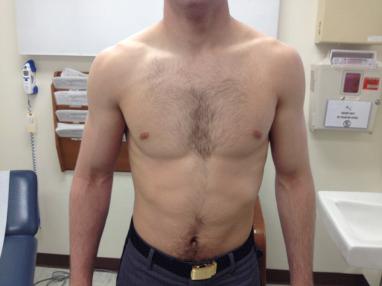
Neurogenic TOS is classically associated with certain provocative tests, although they display high rates of false positives. All tests are positive if they increase symptoms such as pain, paresthesias, or attenuation of the radial pulse. Tests that more specifically delineate compromise in the interscalene triangle are the Adson test and the supraclavicular pressure test. The costoclavicular or military brace maneuver narrows and emphasizes possible compression in the costoclavicular space. The Wright test compresses and stretches structures in the retropectoral space. The elevated arm test (Roos) evaluates for neural compromise throughout the thoracic outlet. Upper limb tension testing indicates brachial plexus compression; however, it may be in the retropectoral space, interscalene triangle, or cervical spine.
The Adson test is performed with the patient's affected arm extended and slightly abducted, the neck tilted toward the affected side, and the patient inhaling deeply ( Fig. 55.6 ). The physician feels the radial pulse before and during the test and looks for obliteration due to compression of the subclavian artery by the anterior scalene. This test can be positive in a healthy person and can be unreliable for arterial TOS if the pulse is already absent as a result of emboli. Tilting the neck to the opposite side (the reverse Adson test) may be a more reliable test that can produce arm heaviness, fullness, pain, and distal numbness in symptomatic patients. The supraclavicular pressure test is performed by placing compression in the retroclavicular space with the thumb in an attempt to compress the brachial plexus and vascular structures ( Fig. 55.7 ). During the costoclavicular maneuver, the patient retracts the shoulders backward and downward to bring the clavicle closer to the first rib in an attempt to elucidate neurogenic or vascular symptoms ( Fig. 55.8 ). The Wright test has the physician hyperabduct and externally rotate the affected extremity of the patient while looking for arm, hand, or pulse changes ( Fig. 55.9 ). The Roos elevated arm test is performed by abducting and externally rotating each of the shoulders 90 degrees while opening and closing the hands rapidly ( Fig. 55.10 ). The test lasts 3 minutes and is positive if the patient feels fatigue, pain, paresthesias, or numbness. Upper limb tension testing is a good screening test for sensitization of neural tissue in the cervical spine, brachial plexus, and upper limb, but it is not specific. The following three positional instructions are performed: (1) abduct both arms to 90 degrees with the elbows straight, (2) dorsiflex both wrists, and (3) tilt the head to one side with the ear to the shoulder and then to the other side. Ipsilateral symptoms are seen in positions 1 and 2. Contralateral symptoms are seen in position 3. A strong positive test is onset of pain and/or paresthesias in position 1 that increases in positions 2 and 3.
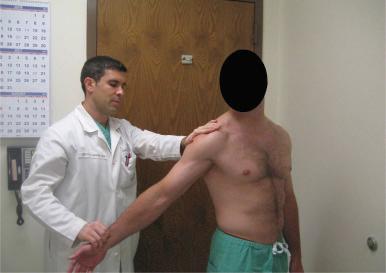
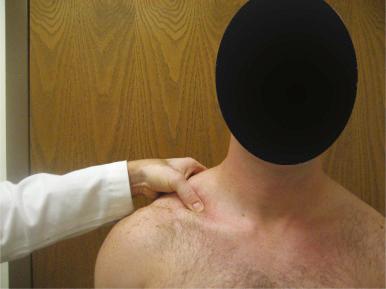
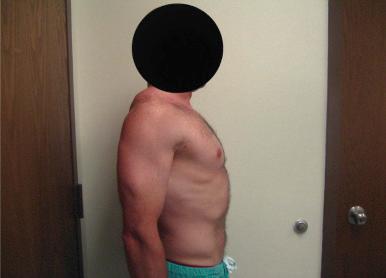
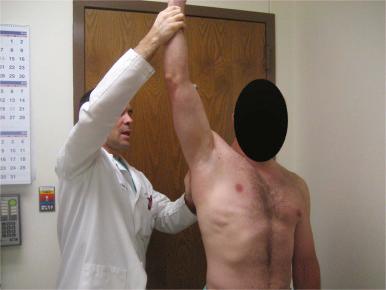
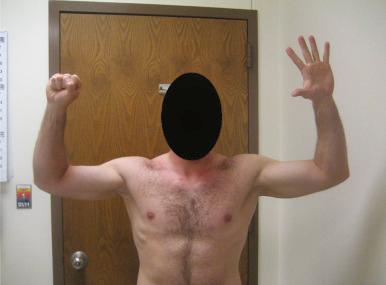
The thoracic outlet consists of three spaces: the interscalene triangle, the costoclavicular space, and the retropectoralis minor space. A leading cause of TOS is the dynamic compression of the neurovascular bundle as it traverses this complex anatomic region. Clinical diagnosis can be difficult; therefore various imaging modalities may be used to show the nature and location of the TOS pathology. Routine radiographs of the cervical spine, chest, and shoulder should be performed at the initial visit to evaluate for degenerative spine disease, cervical ribs ( Fig. 55.11 ), an elongated C7 transverse process, pathologic clavicle fractures, and space-occupying lesions.
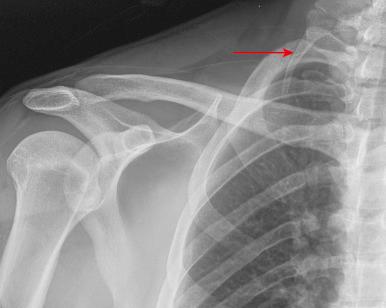
Peripheral vascular studies such as pulses, blood pressure measurements, and Doppler studies aid in the diagnosis of thoracic outlet compression and occlusion of the arterial supply in the arm. Nerve conduction studies and electromyography can be helpful assessments in patients with suspected TOS. These studies commonly show the following results: (1) decreased amplitude in ulnar sensory action potentials, (2) decreased amplitude in median compound motor action potentials, (3) normal or slightly decreased ulnar motor potentials, and (4) normal median nerve sensory potentials. Because the lower trunk (C8–T1) is in direct contact with the scalene muscle tendon and first rib, median and ulnar nerve fibers have a predilection to injury as a result of their origin in the brachial plexus. Other nerve compression pathologies—such as cervical radiculopathy, carpal tunnel syndrome, and cubital tunnel syndrome—can be present by themselves or in addition to TOS. Double-crush nerve compression, which was first reported in 1973, can be a real diagnostic challenge. A study by Wood and Bioni in 1990 showed that 44% of patients with TOS had compression of a nerve distally, with the most common site being the carpal tunnel. Therefore providers must be aware of the potential for further distal compression neuropathy in patients with TOS.
Vascular studies such as arteriography and venography can be useful tools to confirm any extrinsic compression of the neurovascular structures transmitted through the thoracic outlet. Because of patient comfort issues and visual acuity of these classic studies, they have been largely replaced by less invasive procedures such as sonography, computed tomography (CT), and magnetic resonance imaging (MRI). The effectiveness of color duplex ultrasonographic examination has been well documented. A study by Demondion et al. showed the utility of analyzing an arterial cross-sectional area at various degrees of arm abduction. These investigators found a significant difference in stenosis between volunteers and affected patients for all degrees of abduction in the costoclavicular space. Another study examined the association of shoulder laxity with upper extremity blood flow in professional male pitchers using duplex ultrasonography of the subclavian and axillary arteries. The authors showed a significant decrease in arterial blood flow in the laxity group compared with the nonlaxity throwers. Duplex ultrasonography has an advantage of providing dynamic studies in a relatively simple fashion.
Arterial compression is well visualized with the use of CT angiography ( Fig. 55.12 ). The bony architecture of the TOS region can be assessed concomitantly with CT imaging for potential sites of compression. Using CT angiography, LeBan et al. demonstrated narrowing of the costoclavicular space in the abduction–external rotation position in more than 50% of patients with a clinical history of TOS. Another study using CT angiography showed a significant difference in the maximum distance between the clavicle and first rib before and after a postural maneuver in 79 patients. Although CT angiography easily shows extrinsic compression of vascular structures, the size of the CT gantry can limit shoulder abduction. Other limitations of CT include limited visualization of the brachial plexus, use of ionizing radiation, and use of an iodinated contrast medium. Newer open MRI has multiple advantages that permit imaging in preferred planes at appropriate levels of abduction or other postural maneuvers without the use of contrast material or ionizing radiation. Furthermore, MRI permits good analysis of the brachial plexus and muscle hypertrophy, abnormal muscles, and fibrous bands. Demirbag et al. showed significant differences in MRI findings in patients in neutral versus provocative positions in several anatomic parameters such as costoclavicular distance and retropectoralis minor distance. MRI in the neutral and abducted position has become the preferred screening test for patients suspected of having TOS.
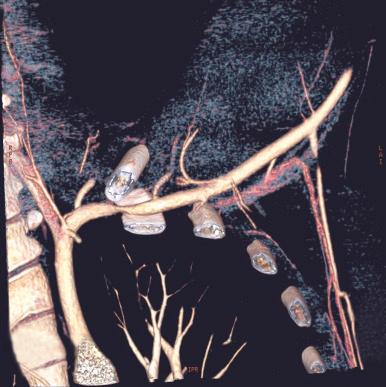
Additionally, expanding techniques in MR neurography (MRN) can isolate the unique water properties of peripheral nerve tissue and locate sites of compression. Baumer et al. showed that in a small series of patients with suspected TOS, increased T2W signal within a brachial plexus MRN indicates areas of relative nerve compression. MRN was also helpful in identifying soft tissue anatomic structures that were causing the compression, which correlated with each patient's surgical findings. This emerging technology may assist in diagnosing TOS and developing targeted surgical treatments; however, more research is needed to definitively understand its diagnostic role in patients with TOS.
ASM and pectoralis minor (PMM) muscle injections have been used for diagnostic and therapeutic purposes. Several case series have demonstrated the safety and efficacy of using ultrasound guidance to inject bupivacaine into the muscle belly, even in high-level athletes. Furthermore, a good response to injection correlates with a positive outcome after certain surgical treatments for TOS. Botulinum toxin has recently been studied as a means of nonsurgical treatment for neurogenic TOS. One study showed that patients experienced substantial pain relief for up to 3 months after a single injection of botulinum toxin into the ASM under CT guidance. This treatment choice may be valuable for nonsurgical patients or may serve as a prognostic tool for surgical intervention.
Acute vascular trauma of the shoulder in the athlete is a rare occurrence and is most often associated with penetrating trauma from foreign objects or bone fragments. Although uncommon and with a majority occurring as a result of motor vehicle accidents in persons who are not athletes, axillary artery injuries from humeral neck and scapular neck fractures have been reported. Clavicular fracture can be a common occurrence in athletes participating in contact sports and cycling, and although most do not have significant sequelae, vessel laceration, pseudoaneurysm, or thrombus can occur. Close attention to vascular status and rapid assessment of fracture pattern with plain films is important, moving on to angiography if indicated. Limb ischemia should be minimized by rapid assessment and movement to definitive treatment if acute vascular injury is suspected. Other traumatic events that can lead to vascular injury are scapulothoracic dissociation, glenohumeral dislocation, and posterior sternoclavicular dislocation.
Scapulothoracic dissociation is an uncommon but severe injury of the shoulder girdle and is usually associated with disruption of the subclavian or axillary vessels and brachial plexus components. The injury occurs most often in persons involved in motorcycle and other motor vehicle accidents, but it can also occur after falls from heights. Attention must be directed to the extremities in these patients, who often have multiple traumatic injuries, and a peripheral vascular examination should be performed, although the extensive collateral network in the area of the shoulder may mask a proximal vascular injury. Lateral displacement of the scapula on chest radiographs is pathognomonic for scapulothoracic dissociation. Comparisons may be made between the sternal notch and coracoid or glenoid notch on each side. CT myelography and MRI are the primary studies for determining the anatomic level of injury, and electromyography is helpful in evaluating the severity of the injury. Surgical decisions regarding limb salvage versus amputation are usually guided by the extent of neurologic involvement. Lesser injuries may involve other components of the superior shoulder suspensory complex that require surgical attention.
Shoulder dislocation is a common injury that can occasionally present in association with vascular injury. The axillary artery is vulnerable because of its fixation to the humerus via the circumflex scapular artery and may be damaged by the pectoralis minor tendon, which may act as a fulcrum when the humeral head displaces anteriorly. These arterial injuries are not likely to occur in a young, athletic population; however, dislocations in this population are frequent. Luxatio erecta, a glenohumeral dislocation in which the humeral head is displaced inferior to the glenoid with the humeral shaft parallel to the scapular spine, can present with vascular occlusion or injury. Suspicious peripheral pulses or swelling should prompt angiography and appropriate revascularization if necessary.
Sternoclavicular injuries account for only approximately 3% of shoulder girdle injuries, with anterior dislocations far more prevalent than posterior dislocations. The proximity of the great vessels, esophagus, and trachea and their possible compression make the posterior sternoclavicular dislocation potentially life threatening. Although motor vehicle accidents are the major cause, up to 21% of these injuries can be sports-related. Patients usually have a history of trauma to the sternum or scapulothoracic area and may report dyspnea, dysphagia, dysphonia, pain over the clavicular head, or swelling. Examination should include evaluation of peripheral nerve function and a change in symptoms with arm positioning. CT is ideal for confirming the diagnosis. Closed reduction is usually successful and can be performed with traction in line with the clavicle, with a bolster placed between the scapulae of the supine patient and a thoracic surgeon available if necessary. Spencer and Kuhn have described a figure-eight reconstruction of the sternoclavicular joint with a semitendinosus graft that closely mimics the stability of the intact joint for patients with persistent instability of the medial clavicle.
Vascular TOS does not usually respond to conservative management and requires surgical intervention. Prompt recognition of arterial TOS with appropriate imaging studies is important in an attempt to prevent distal ischemia. Studies with the arm abducted can identify possible compressing structures that may require augmentation surgically along with treatment of the vessel itself. Venous TOS, when diagnosed, is initially treated with anticoagulants and thromboprophylaxis and also usually requires surgical management consisting of thoracic outlet decompression around the axillary and subclavian veins and venous reconstruction if necessary.
Neurogenic TOS can be thought of as either true or nonspecific. True neurogenic TOS warrants surgical management for decompression of the affected brachial plexus structures. True neurogenic TOS tends to be relatively painless and has abnormal neurologic and electrodiagnostic findings. Nonspecific TOS is associated with chronic pain and few definitive neurologic and electrodiagnostic findings. Neurologic findings in persons with true neurogenic TOS involve the lower plexus, with more symptoms in the more tensioned T1 anterior primary rami than the C8 anterior primary rami, which produces a more pronounced effect in the thenar eminence muscles than in any other group. In most cases, nonspecific TOS is treated conservatively, with surgical decompression as the final treatment choice after extensive discussion of the potential risks and possible complications of surgery in the complex thoracic outlet region. A proposed algorithm ( Fig. 55.13 ) may help to guide decisions for treatment.
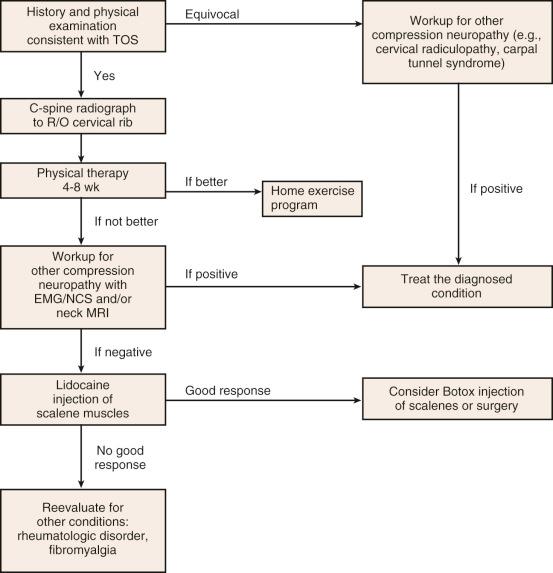
Conservative management should be the initial treatment for nonspecific neurogenic TOS. Initial pain relief may be obtained through the judicious use of anti-inflammatory drugs and muscle relaxants. Selective muscular (ASM or PMM) blocks can relieve pain temporarily and can assist in the diagnosis. An ASM or PMM injection of botulinum toxin is an additional option for temporary pain relief while physiotherapy is performed. After initial pain relief, conservative management begins with patient education about symptoms and prognosis to help ease anxiety and increase compliance with home exercise programs. Education also centers on activity modifications such as improving posture while sleeping, working, and driving. Costoclavicular space mobility may be improved by working on the diaphragm and scalene muscles. Mobilization of sternoclavicular, acromioclavicular, and first rib costovertebral joints is also stressed. First rib mobilization and scalene muscle stretching can help widen the posterior scalene triangle. The retropectoral space is mobilized through stretching of the pectoralis major and minor muscles. Vanti et al. performed a review of 13 studies of conservative management of TOS and found that 76% to 100% of patients with nonspecific neurogenic TOS had good or very good results at short-term follow-up and 59% to 88% had good or very good results after at least 1 year. Novak et al. found that obesity, worker's compensation, and double crush pathology involving the carpal or cubital tunnels were associated with poor outcomes.
Surgical decompression is warranted in patients with true neurogenic TOS and in those with nonspecific TOS when conservative management has failed. Specific surgical treatment for TOS is controversial because of the complex nature of presenting symptoms, the difficulty of isolating a specific site of neurologic compression, and the pathoanatomy involved. Decompression of offending structures in the thoracic outlet is the goal; this usually involves removal of the first rib, release or removal of portions of the anterior and middle scalene muscles, pectoralis minor tenotomy, supraclavicular decompression, and removal of cervical rib when applicable. Some surgeons prefer to get to the thoracic outlet through the transaxillary approach, first described by Roos in 1966 and popularized by Urschel, with the patient in a posterolateral position and the arm elevated above the head. Advantages include a hidden incision in the axilla and excellent access to the first rib unhindered by the neurovascular structures. The disadvantage is limited access to the neural structures, congenital bands, and cervical ribs that lie behind the vascular structures. The supraclavicular approach is most commonly used for TOS decompression, which allows a wide exposure of the supraclavicular plexus and the middle third of the first rib.
Recently endoscopic treatments have been described for TOS. Lafosse et al. described an all-endoscopic technique for infra- and supraclavicular brachial plexus neurolysis and decompression. He has subsequently performed this technique on a series of 21 patients who showed improvement in symptoms and functional scores with no complications reported at 6 months of follow-up. Also, George et al. has described a video-assisted thoracoscopic surgery (VATS) approach to first rib resection for patients with TOS. All 10 patients in his series had resolution of symptoms, with 1 patient experiencing transient mild loss of function and sensation that resolved by 8 months postoperatively. These new techniques require an expert knowledge of the anatomy as well as endoscopic skills.
QSS can be treated in a manner similar to the treatment of nonspecific neurogenic TOS, with conservative management initially. Treatment begins with reassurance, relative rest, observation of and possible changes to athletic biomechanics, and therapy that includes stretching of the posterior capsule and teres minor. Surgical decompression is performed if conservative measures fail, with dynamic testing performed at the time of surgery to ensure complete release of the axillary nerve and maintenance of the radial pulse via the posterior circumflex humeral artery.
Arterial TOS involves surgical treatment of the compression of the vasculature, as well as treatment of the vessel itself. Decompression often involves removal of the cervical and first ribs, scalenectomy, and excision of constricting bands. Thrombolytic or balloon angioplasty can be performed for acute ischemia. Arterial degeneration, aneurysm, and intimal damage require bypass grafting or arterial reconstruction.
A review of the pathophysiology and treatment of venous TOS is shown in Fig. 55.14 . Initial treatment begins with anticoagulation and thrombolysis. The next step in treatment is to decompress the thoracic outlet impingement of the subclavian vein with first rib resection, medial claviculectomy, and scalenectomy as indicated. Venous reconstruction is then performed depending on the status of the vein and symptoms at the time of surgery. Comprehensive surgical management is advocated, with (1) early diagnosis, thrombolysis, and tertiary referral; (2) periclavicular thoracic outlet decompression and frequent use of venous reconstruction; and (3) temporary postoperative anticoagulation, with an adjunctive arteriovenous fistula if necessary.
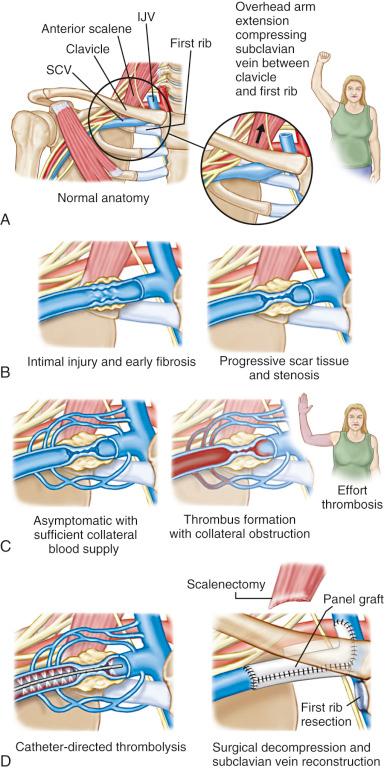
Surgical treatment of vascular TOS is generally successful, with outcomes slightly more improved in arterial TOS compared with venous TOS. In the treatment of combined vascular TOS, Davidovic et al. reported complete resolution of symptoms with all cases of arterial TOS but persistent symptoms in patients presenting with axillary-subclavian venous thrombosis when treated with cervical/first rib resection, decompression of all soft tissue elements, and combined vascular procedure. Athletes who engage in overhead movements in their sport have particular success in returning to sport without symptoms after treatment for arterial TOS, including professional baseball players. The treatment of venous TOS has evolved from delayed decompression and definitive vascular procedures after a prolonged period of anticoagulation to more rapid decompression after thrombolysis if the condition is diagnosed within 14 days. Delayed decompression and definitive vascular procedures yielded only a 40% success rate in 10 patients, with 6 patients requiring additional procedures to achieve venous patency, whereas more rapid decompression after thrombolysis yielded an initial success rate of 83% at 5-year follow-up. A recent report by Melby et al. revealed 100% patency in 32 athletes with effort thrombosis at 10 months, although 7 patients underwent secondary procedures.
Long-term results after the treatment of neurogenic TOS are difficult to elucidate because of differing diagnoses, the complexity of symptoms, and the wide variation of surgical treatments. Mingoli et al. reported a long-term outcome of 81.4% good to excellent results and a reoperation rate of 15% in a mixed population of patients with TOS treated with a transaxillary extraperitoneal first rib resection and scalene muscle transection. Atasoy also saw improvement in 95 of 102 patients treated with a combined transaxillary first rib resection and transcervical scalenectomy, and 60 patients reported good to excellent results. A retrospective review of patients with mixed TOS treated with a supraclavicular surgical decompression with or without first rib resection at a single institution reported 95% improvement in patients with nonspecific TOS with a minimum 3-year follow-up. Vemuri et al. compared outcomes of patients treated with a pectoralis minor tenotomy versus tenotomy plus supraclavicular decompression, scalenectomy, and first rib resection. They found no significant difference in comparing both groups’ outcomes but noted that the tenotomy-plus-decompression group included more patients with a bony anomaly and a history of injury.
A recent systematic review of outcomes following surgical treatment for TOS found more reliable improvement in patients with arterial TOS and venous TOS (90% excellent/good results) as opposed to patients treated for neurogenic TOS. However, 56% to 89% of patients with neurogenic TOS reported improvements in their symptoms and a mean 28.3 point improvement in Disabilities of the Arm, Shoulder, and Hand (DASH) scores. It was difficult to draw conclusions because all studies lacked a standardized method of diagnosing neurogenic TOS, of treating neurogenic TOS, and of obtaining outcome measures. The authors recommended that future studies should focus on these three areas of improvement. QSS decompression seems to be quite successful, with a recent report on four athletes whose sport required overhead motions returning to full activity without symptoms 3 months after undergoing release.
Surgical complications range from general complications, such as wound healing problems and infection, to those inherent to the delicate anatomy of the thoracic outlet area, including blood vessel damage and possible exsanguination, brachial plexus injuries resulting in severe sensorimotor dysfunction, and nerve injuries and transections (affecting the long thoracic, phrenic, intercostal brachial, supraclavicular, and cutaneous nerves as well as causing Horner syndrome). Apical hematoma, pneumothorax (in up to 33% of patients), hemothorax, chylothorax, and thoracic duct injury have also been encountered. Incomplete resection of the first rib or failure to resect constricting congenital bands can lead to continued symptoms and surgical failure. Despite moderately good results in most patients, the risk of devastating complications has prompted some authors to critically evaluate the need for surgery. The serious potential for injury emphasizes the need for familiarity with the anatomy of the thoracic outlet.
The postoperative management of patients with TOS can be simple or complex, depending on the underlying pathophysiology and the surgical procedure used. Surgery ranges from resection of the scalenus anterior to resection of the first thoracic rib. Vascular pathology, such as aneurysm or thromboembolism, must also be addressed at the time of thoracic outlet decompression. After decompression, patients are generally allowed limited ROM of the arm for 3 to 4 weeks for activities of daily living. Active ROM exercises typically begin at 6 weeks after surgery, with return to play (RTP) between 4 and 6 months after surgery. If a patient requires anticoagulation after vascular surgery, early mobilization is not only encouraged for ROM maintenance but may actually reduce the long-term symptoms of postthrombotic syndrome. Athletes may RTP with a gradual increase in intensity and duration after completing their course of anticoagulation. Todd et al. reported on a professional pitcher who returned to the Major League 4 months after saphenous vein interposition grafting of the axillary artery. Bottros et al. also reported on an MLB pitcher who was able to return to pitching in the major leagues one season after surgical treatment of neurogenic TOS. Chang et al. studied the physical and mental component scores on the Short Form–12 scale after surgical decompression of neurogenic TOS and found that the median time to recovery of normal quality of life was 23 months for physical function and 12 months for mental function; however, only 50% of their patients had returned to work at the time of the last follow-up.
Vascular problems involving the shoulder are relatively uncommon but can result in pain, and may have a profoundly deleterious effect on an athlete's performance; they can also lead to potentially limb-threatening situations. TOS generally comprises any compression of brachial plexus elements and/or subclavian vessels as they pass from the cervical area to the axilla and proximal arm. Although these conditions are rare, the sports medicine surgeon should consider TOS in the differential diagnosis when more common causes of pathology are excluded or the patient's history is suggestive of the condition.
Become a Clinical Tree membership for Full access and enjoy Unlimited articles
If you are a member. Log in here